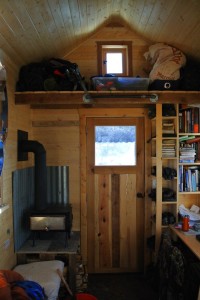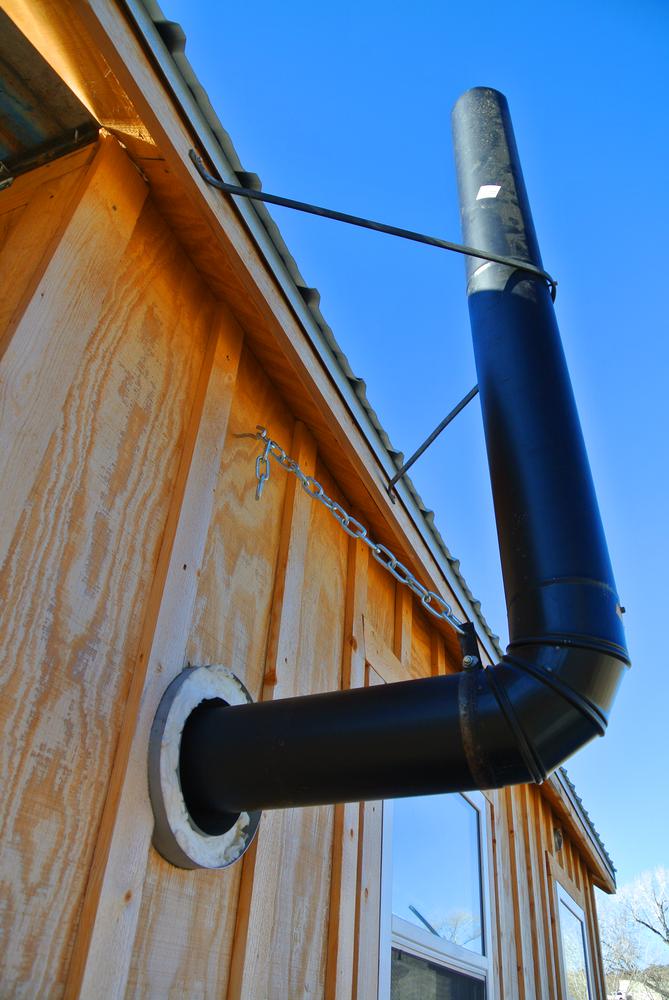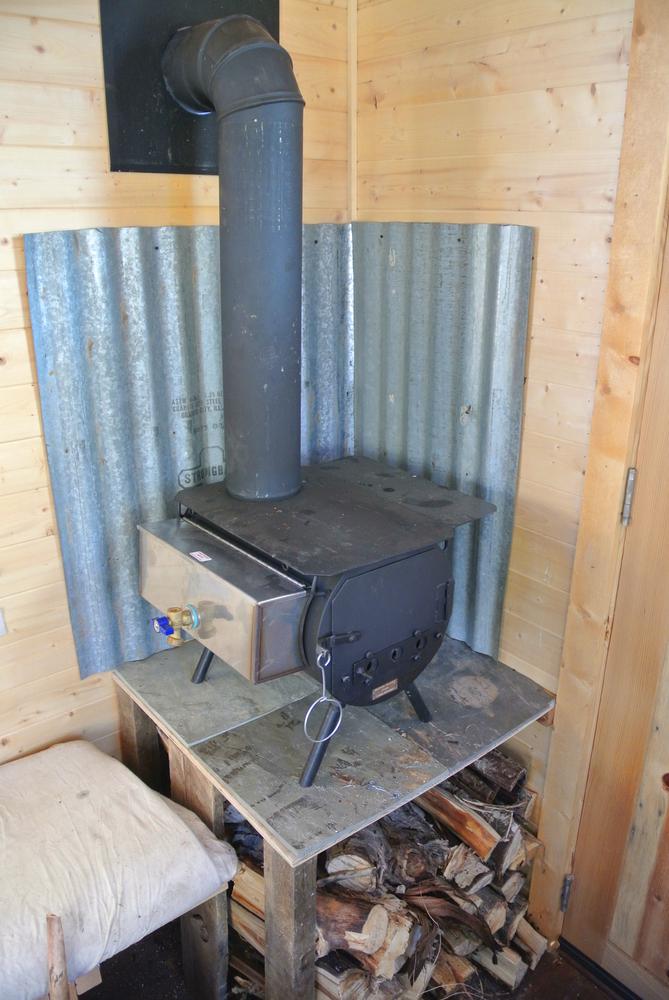 Today I’d like to share with you a component of my tiny house that brings me great pride and warmth: my woodstove. Heating a house in the rocky mountains, and any cold climate for that matter, is always an important thing to figure out. Tiny houses, by their nature, don’t require much energy to heat, especially the ones I build, but tiny home owners, by their nature, are always looking for ways to simplify, save money, and reduce their footprint. With the rising costs of fuel and/or electicity, woodstoves make a lot of sense. There’s also something nostalgic and enduring about them. If any of you have ever shopped around for a woodstove to put in a tiny house, you’re probably aware of how hard it is to actually find a model that is just the right size and doesn’t cost a fortune. Some of the more popular models I have come across cost at least $1000 if not more. This doesn’t even include the cost of stove pipe, wall thimbles, elbows, accessories, etc. This wasn’t an option for me, so I kept looking.
Today I’d like to share with you a component of my tiny house that brings me great pride and warmth: my woodstove. Heating a house in the rocky mountains, and any cold climate for that matter, is always an important thing to figure out. Tiny houses, by their nature, don’t require much energy to heat, especially the ones I build, but tiny home owners, by their nature, are always looking for ways to simplify, save money, and reduce their footprint. With the rising costs of fuel and/or electicity, woodstoves make a lot of sense. There’s also something nostalgic and enduring about them. If any of you have ever shopped around for a woodstove to put in a tiny house, you’re probably aware of how hard it is to actually find a model that is just the right size and doesn’t cost a fortune. Some of the more popular models I have come across cost at least $1000 if not more. This doesn’t even include the cost of stove pipe, wall thimbles, elbows, accessories, etc. This wasn’t an option for me, so I kept looking.
While on my big summer trip across the Rockies, I stopped in an outfitter outside of Whitefish, MT to buy some bear spray before heading into Glacier National Park. They sold a lot of cowboy tents and accessories, among them, small cylinder stoves that are designed to easily be packed on horses. I thought to myself, these are the perfect size! Plus, they were much more affordable, ranging from $200-$500. When I got back home, I did some more research and found Colorado Cylinder Stoves, a small company in Grand Junction, CO that manufactures these small stoves.
I called Wes, the owner, and we talked for a while about what I was looking for. He was quick to point out that the stock models they sell were not really designed for full time winter use, maybe one month out of the year. However, he got to thinking about it and said that he could just beef up the metal gauge and then it likely would be good for heavier use. We came up with a custom design, he made it, shipped it, and I installed it. I’m happy to say it is just what I was looking for! If you are considering a woodstove for your tiny house, I would give this one some serious consideration. Here are the details, and some pictures.
My custom model is based on the Mesa package. The dimensions are the same, it just uses thicker steel, so it won’t warp if it gets real hot, and it will hold up much longer. It is a little heavier, of course, which does factor into tiny house design, but the whole thing still weighs less than 50 lbs, even with the stove pipe and accessories. It’s small, after all. The package came with the stove, some threaded legs that can be cut to adjust the height, a coal grate, a stainless steel water heater that mounts on the side, a spark arrestor, the stove pipe, a flue, a stovetop extension, and a wall thimble, a part that safely allows the stove pipe to pass through the wall.
I started out by building a platform that I can store firewood under, but it also raises the stove off the floor enough so I don’t have to bend down to put wood in. I also have a couch kind of close to the stove, so this gives me a safer distance from the unit to my couch mattress. I put some slate tile down to protect the plywood from heat. I then chopped the legs so the stove sits 6″ above the slate. The stove pipe comes in 24″ lengths. I installed the flue per instructions and ran the first piece up, put an elbow on, then cut my hole in the wall for the thimble. I ran another 24″ piece horizontal thru the thimble, and then another elbow, and two more lengths straight up. I secured the stove pipe to the house using a piece of scrap steel and a chain I had laying around. This steadies the pipe during hard winds, and also keeps it from falling down. To finish things off, I placed some scrap corrugated metal in the corner to reflect the heat into the room and keep the tongue and groove pine wall from getting too hot.
 I’ve been using the stove for over a month now and it works great! You can control the fire level by adjusting the flue and the air intake, which is a simple slider bar covering some holes in the door. It’s so simple, yet so effective. If the stove had a downside, it would be that you can’t fit huge logs in it. But then again, we’re talking about tiny houses here, so you don’t really need to. Even on subzero nights I’ve had to crack windows because this thing was already putting out so much heat. Unlike my propane heater, which just kind of heats the air and relies on convection, a woodstove also heats by radiation, which is more comfortable. It’s the same way the sun heats your body. The radiant heat actually heats the surface of the house, as well as any nearby objects. It’s a deep heat that will last into the night. At some point, the fire will die out and the heat will taper off, but for me this doesn’t seem to happen until about 6am the next morning, at which point, my propane heater will kick on using the lowest setting and keep things warm enough until I wake up and either leave the house or decide to get the fire going again.
I’ve been using the stove for over a month now and it works great! You can control the fire level by adjusting the flue and the air intake, which is a simple slider bar covering some holes in the door. It’s so simple, yet so effective. If the stove had a downside, it would be that you can’t fit huge logs in it. But then again, we’re talking about tiny houses here, so you don’t really need to. Even on subzero nights I’ve had to crack windows because this thing was already putting out so much heat. Unlike my propane heater, which just kind of heats the air and relies on convection, a woodstove also heats by radiation, which is more comfortable. It’s the same way the sun heats your body. The radiant heat actually heats the surface of the house, as well as any nearby objects. It’s a deep heat that will last into the night. At some point, the fire will die out and the heat will taper off, but for me this doesn’t seem to happen until about 6am the next morning, at which point, my propane heater will kick on using the lowest setting and keep things warm enough until I wake up and either leave the house or decide to get the fire going again.
So what about cost? Everything pictured above, including shipping to my door, cost less than $500. Still a chunk of change, but considering what you get, it’s a great deal. My firewood was free. There are tons of downed cottonwood trees on the property I live on, most of which have been seasoning for years. I just had to collect, cut, split and store, so perhaps there’s a bit of sweat equity involved, but I consider this a good workout, and instead of paying for a gym membership I’m providing myself with nice comfortable heat for the winter.
There are of course some more options for woodstoves in a tiny house, but for now I just wanted to focus on this one since I am personally using it and having fantastic results. If you wish to order one from Colorado Cylinder stoves, tell them you heard about them from me, and make sure to explain that you need the same design and package that I ordered. One last thing that I and I am sure they will point out, is that these stoves are not UL listed and they were never designed for this type of application. Well, my bike was never designed to be used as a snow plow, but I’ll be darned if it doesn’t move some snow around quite easily. Just use common sense, read and follow directions, don’t over-fire the thing, and you should be good to go. I’m not responsible if you burn your house down because of carelessness or improper installation. The same holds true for any woodstove though, so please know what the heck you are doing, and if you don’t, hire a professional.


The stove looks great although your clearances to combustible materials makes me nervous. I’m pretty sure that code calls for 12″ clear of anything combustible, which you seem to be short of, particularly on the walls. I don’t say that because I’m a code nazi but because that’s one of the more pragmatic restrictions in there. I appreciate the steps you’ve taken to manage the danger although I’d recommend going a bit further, especially since I suspect you wouldn’t have to change your setup drastically. I’d talk to someone more in the know but I suspect there’s a ceramic heat shield product, or something similar, that you could put between the corrugated metal and the slate to better isolate some highly flammable materials from a high-heat source.
Best,
Scott
Since it is not UL listed, as mentioned, it didn’t come with any clearance to combustibles minimums. A fireplace specialist has actually contacted me with some concerns and I do plan to make a few small modifications, but as it stands, when I run the stove fairly hot the surrounding walls get hot to the touch but not so hot that it burns my hand. The key is to run the corrugated metal all the way up a few inches higher than the stovepipe, and to hold it off the wall with non combustible 1″ spacers. There is almost zero heat transferring to the slate tile. I’ve tested it time and time again and the result is always the same. Thanks for the comments and stay in touch for some updates.
Greg
Nice little stove. But (I know, I know, everyone is a critic) just a couple of points. First, putting it up hirer does make it easier to load (which is nice). But it also is making your inside pipe shorter which I turn makes you not get the extra heat from the pipe and means it is hotter while it is going through the wall (can start a fire inside the wall where it passes through). Also with the stove lower it hearts the room more efficiently(yes I understand that with the house being so small it doesn’t really matter but had to mention it ). Second, with the stove that close to the heart shield you really should have at least a inch between the shield and the wall. If you have another piece of that roofing and put it on the opposite way to make channels should work pretty good I would think. The last time my neighbor just used some metal strips (some sorry of bracket pieces he had laying around). Sorry but I had to say something- I would hate to see you burn down your lovely home.
Have A Pleasant Day
I would like to Know more about these Stoves & others you might make.
What no one has mentioned is that running stovepipe as opposed to insulated chimney pipe outside is asking for creosote build-up. Also, while your set-up is quite impressive, & the one inch spacers make the wall protection ok – keep in mind over time the combustion temp of your siding drops. Safe today, maybe not tomorrow. I would also allow another 12 inches in front of the opening for sparks and a side shield for the couch. Check out fire protection code – I think it’s 211 – and kudos to you and your supplier. Great idea!
Hi Pam!
Thanks for your feedback. Creosote buildup is a legitimate concern with uninsulated pipe outside. After a winter of moderate use, I took everything apart to move the house. I inspected the pipe during this time. There was indeed some buildup. It wasn’t enough to cause concern, but it did remind me to leave a comment that the pipe should be thoroughly cleaned after each season and ideally even once or twice midseason. This is a good idea for all woodstoves! Best, Greg
We had a monster airtight THING in our century-old two story farmhouse when I was a teenager. There was a three tablespoon scoop inside a plastic canister fll of powder thrown every 24 hours in that wood heater to dampen down creosote build-up. Don’t know if you can still find it today but everyone is right – a little more clearence would be best. Every two to three days it was my job to shove the pipe-brush to the top and down a few times to remove the creosote from inside the pipe – being covered in cinders every time! You’ve a terrific home and a great heating and emergency cooking solution. Good luck!
How well did the stove work overnight or while you were gone?
It only holds heat for about 3 hours when I go to bed.I have a propane heater on a thermostat that kicks on when the temp gets low enough, usually at about 5 in the morning. The houses are so small and well insulated that it doesn’t have to burn much. I just get a fire going when I wake up and the propane shuts off soon after. If I’m gone for a while (as in a few days or more), I just make sure my water tank is empty so nothing freezes.
How much $$ i would like to buy one for my hunting cabin..
Hey Greg, do you have info on your propane heater? Is it the Dickinson Marine fireplace? That one looks almost perfect, but it doesn’t have a thermostat. Sounds like your has a thermostat. Thanks!
Mine is a ventless heater, not the Dickinson. I can get away with ventless because wood is my primary heat, and I live in a dry climate, and my house is not hermetically sealed. Otherwise, ventless might cause moisture and condensation problems. There are vented propane heaters available that work with a thermostat.
What kind of thimble did you use, and where did you find it? Having a hard time figuring out what kind to use to go through a wood wall. Thx
Excellent! I want one and a house in the mountains to go with it! 🙂
Comments:
Is your stove secured so it will not fall in an earthquake and dump hot embers and smoke into your house? I might consider putting a couple of eye bolts into the adjacent walls and going around the stove with a wire or cable as a jerry rigged method. Something like they do with water heaters so they don’t fall over. Also, consider anchoring the support table below the stove as well. Don’t want it to start wobbling in a quake.
Also, I’d want a cap to keep rain out of my pipe. And it looks like the upper section of pipe is restrained for horizontal movement with a single small bolt. I’d be concerned about it in a high wind. As a jerry rigged safety I’d wrap a steel wire around the stove pipe to tie it to the steel brace to better take horizontal wind forces.
Doubt my suggestions would meet any codes, so do your own due diligence. Congratulations on a nice place to live.
Hi there I have a very similar cabin and I will be using a very small wood/coal stove. How did you pass the pipe through the wall? Is it just an insulated thimble with single wall stovepipe going through it?
Yes, it is just single wall going through an insulated thimble. If I were to do it again, I wouldn’t run the pipe through a wall, but instead thru the roof. If the only option i had was through the wall, then I would use double wall pipe into the thimble. I haven’t had any issues, but I don’t run the fire blazing hot either.
Looking a doing a similar setup in my tiny cottage behind my house. Coming up on almost 4 years since install, how has the single wall pipe been holding up to elements/stove use?
That single wall has gotten some surface rust, but still kicking along! The stove itself is showing very little wear and tear. I reckon it’ll got another 20 years easily. I might eventually upgrade the pipe to doublewall.
My tiny house has almost been completed, and I’m wondering how much wood it goes through. I’ve purchased the same stove, and my house is 20×8. Thanks if you have any input!
depends on how cold it is, how well insulated your house is, and how warm you like it! Here in Durango, I probably burn 1/4 cord a year, maybe closer to 1/2 if its really cold.
You did an amazing job! So much creativity and research went into your work and it shows. I love that you solved your problem of keeping warm and did it all at a very reasonable price. I’m in the same boat currently and don’t you just love all the “professionals/experts/code hunters” having to leave their unhelpful comments? Instead of just saying how cool it is, they MUST be annoying and post their useless opinion. Bottom line is, you got out there and solved your problem, you’re living your amazing life and making it work unlike the rest of them. Keep at it and keep up the great work you are doing! It’s very inspiring.